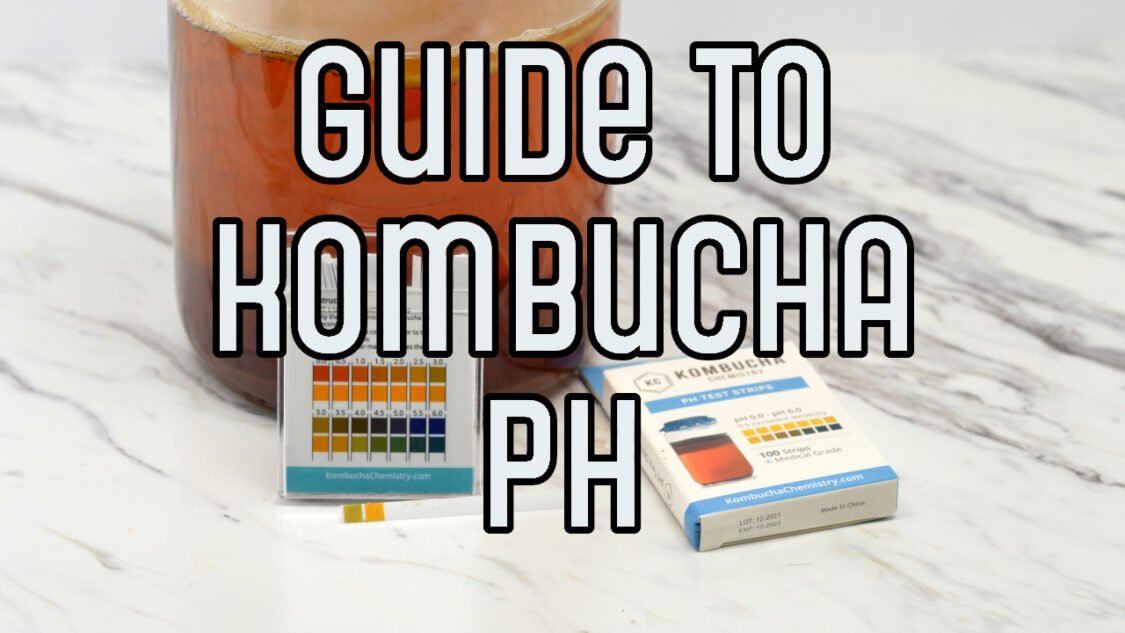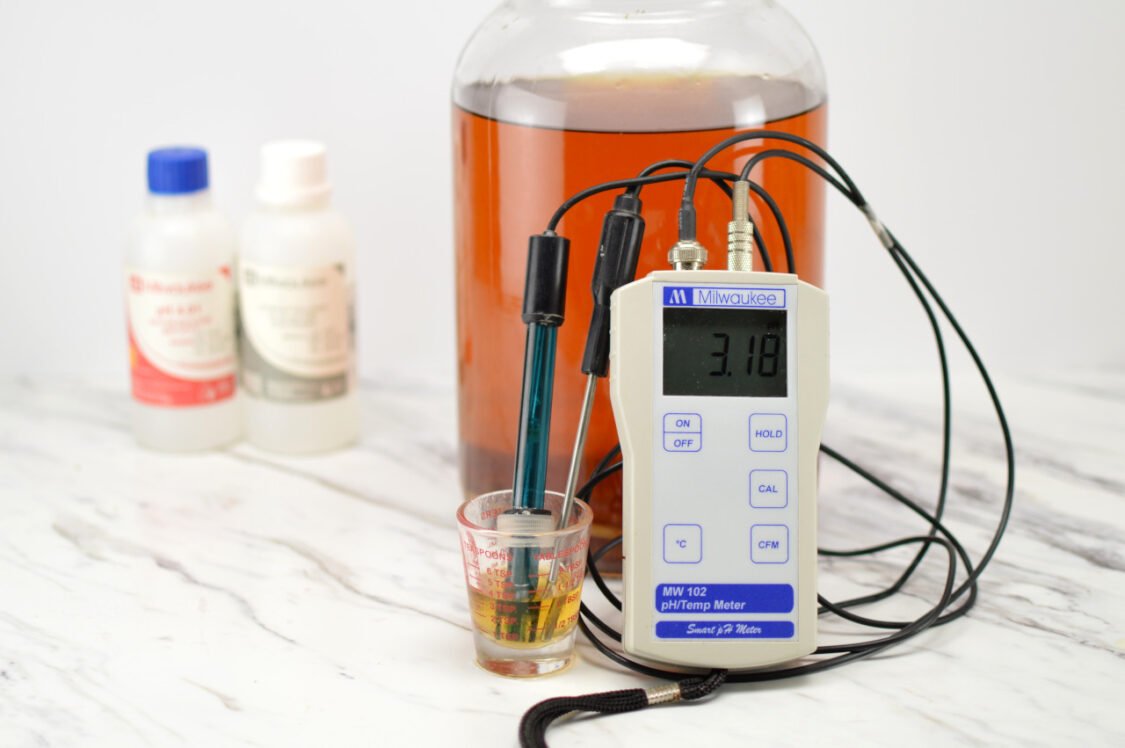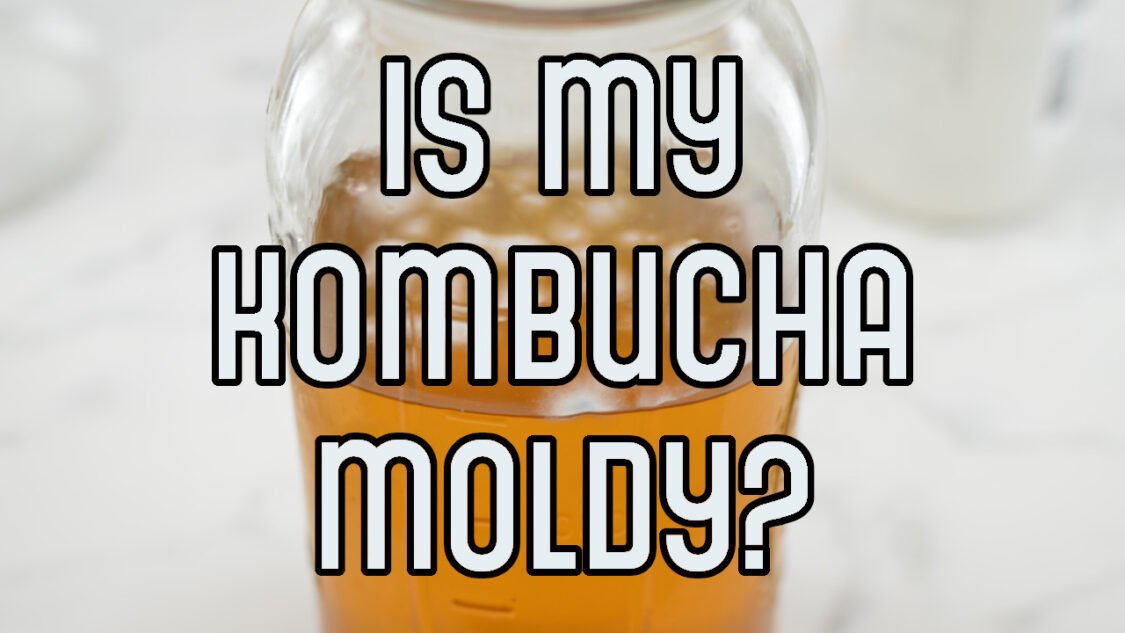Guide to Kombucha pH
pH is not an indicator of doneness, and it’s not a measure of sweetness so what is pH? This guide to kombucha pH answers all of your questions.

What is PH?
pH is a measurement of the acidity or alkalinity of a solution. When a substance dissolves in water, it produces charged molecules known as ions. Acidic water contains extra hydrogen ions (H+) and basic (alkaline) water contains extra hydroxyl (OH-) ions.
The pH value of a liquid is determined by the number of the free hydrogen ions present in that drink. Every liquid has a number of free “ions” . The more free ions in a liquid, the more acidic the liquid. The pH scale ranges from 0-14 with readings in the 0-7 range termed acid and readings in the 7-14 range termed alkaline (or basic). 7 is considered neutral
pH plays an important role in protecting the SCOBY from microbial invaders. Kind of like a chemical force field, the low pH creates a highly acidic environment in which our native bacteria and yeast thrive but simultaneously inhibits the growth of disruptive foreign & potentially harmful microorganisms.
What is the ph of kombucha?
At the start of your first fermentation (i.e. right after you’ve combined sweet tea and starter liquid), the liquid should be below pH 4.5
Your brew’s pH should drop below 4 in the first few days of fermentation.
Once it’s below 4, it is acidic enough to be considered fairly safe from developing mold or harmful pathogens, but it will still probably taste too sweet to bottle. You’ll want to continue fermenting it to get a better balance of sweet and tart. At day 7, you can begin tasting your brew. If it’s too sweet, cover and allow to ferment longer. Continue tasting daily until this balance is achieved – up to 21 days.
How pH changes during fermentation
Start of fermentation: I consistently found that my brews had a starting pH of around 3.9 – 4.2 immediately after I added my starter tea.
Days 2-3: the pH usually drops to around 3.6 – 3.8.
Days 7 – 12: my preference for the finished kombucha is a pH between 3.2 – 3.4; however, anywhere from 2.5 to 3.5 is acceptable.
Days 13 – 21: kombucha will continue to ferment to become less sweet and more tart.
How do I measure ph?
pH test strips: These are the easiest solution since you merely dip it into your liquid, and it rapidly changes color based on the pH of the liquid. Compare the strip to the chart on the package to determine the pH that corresponds to the color of the strip. These are not as exact as other methods but cannot be beat for the price and convenience.
You wan to ensure you buy ones that measure the lower end of the pH spectrum. I have found these kombucha specific strips work great (affiliate link 
pH meters: pH Meters are more accurate than test strips but require calibration and more care so they are not as easy. There are a variety of styles and price points on pH meters. Typically a simple and less expensive one is suitable for home kombucha brewing. This is an affordable, all-in one pH meter (affiliate link 
You will also need at least one buffer solution. For Kombucha the 4.01 pH solution is ideal since kombucha registers on the lower end of the pH scale. Before using your meter for the first time (and periodically) you will need to calibrate it. If you have a buffer solution that’s 4.01 and your meter registers 4.05 when dipped into the buffer, your pH meter needs to be calibrated. Follow the instructions that came with your meter to adjust the reading back to 4.01.
After calibrating your pH meter, remember to rinse it well with distilled water before using it to measure your kombucha! After using the meter It’s recommended to rinse it with distilled water and storing the tip in a storage solution.

What My KombuchA PH is too High?
If the initial pH of your sweet-tea and starter mixture is too high (above 4.5) it will not inhibit the growth of unwanted bacteria. This could potentially lead to a resulting beverage that could be very dangerous to consume. Here are two ways to adjuist the pH prior to the start of fermentation:
Add finished kombucha or starter liquid: the addition of finished kombucha (homemade or store-bought), leftover starter liquid from a previous batch, or liquid from a SCOBY hotel are all effective ways to reduce the pH of your unfermented kombucha. Start by adding 1 cup at a time, mixing thoroughly and measuring the pH until it is below 4.5
Add White Vinegar: While not as preferable as adding kombucha or starter liquid, the addition of white vinegar will also effectively lower the pH. Add 1/4 cup at a time, mixing thoroughly and measuring the pH until it is below 4.5
WHAT IF MY KOMBUCHA IS TOO ACIDIC?
If you your fermentation ran a little too long (life happens!) and now your kombucha is extra acidic and tastes too much like vinegar you can attempt to salvage in one of three ways:
Sweeten: Add a sweetener such as honey or table sugar and moving the fermenter to the a cool are (or refrigerator) to stop the fermentation. If you like the taste, flavor and bottle as usual.
Bottle: Another option is to bottle it as is and store it in the refrigerator to be used as a starter tea for future batches or to lower the pH of a subsequent batch if it’s too high.
Dump: Sometimes you have to cut your losses and dump out the batch (saving the SCOBY and enough starter liquid for your next batch)
KOMBUCHA AND ACID REFLUX
Since it’s well known that Kombucha is acidic it’s worth considering if kombucha can aggravate acid reflux. Kombucha is not ideal for those suffering from acid reflux. The acidic nature and caffiene in kombucha can aggravate acid reflux. Additionally, carbonation in kombucha expands within the stomach and can push the highly acidic stomach acid up the esophagus leading to a burning sensation typical of acid reflux.
Ph of Common Kombucha Ingredients
Kombucha Starter Tea – This tea has come from a previous batch of fermented kombucha tea so the pH will be at that kombucha tea pH level, roughly 2.5 – 4.
SCOBY – Since a SCOBY is usually stored in a SCOBY hotel or transported in starter tea, it soaks up the kombucha fluid. Just like the starter tea, it will likely lower the pH of the new batch.
Water – Water has a pH of between 6.5 – 8, most commonly 7 – aka pH neutral. Addition of other ingredients easily moves a liquid with neutral pH.
Sugar– Both when as solid or when dissolved in liquid it will not change the pH of the liquid it’s added to–the impact is zero so the pH before adding and after adding sugar will be the same.
Honey – Most honeys fall into a pH range of 3.4 – 6.1 . Slightly on the acidic
Tea – The pH of tea depends on the type you’re using to brew with. Green tea is relatively high at 7 – 10 whereas black tea is much lower at 4.9 – 5.5.
Helping you learn to brew kombucha, find inspiration for new kombucha flavors and use kombucha to make kombucha mocktails




